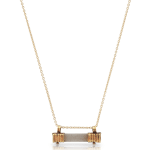


Roman
Gold and rock crystal amulet pendant, Late Roman, circa 4th - 6th century AD
Gold, rock crystal
Length: 2.4 cm
Length of chain: 18 in (adjustable to 16 in)
Length of chain: 18 in (adjustable to 16 in)
Sold
Further images
A rock crystal amulet pendant of square cross-section with two fitted gold caps at each end. Two loops above for suspension. Modern 18 carat gold chain.
A rock crystal amulet pendant of square cross-section with two fitted gold caps at each end. Two loops above for suspension. Modern 18 carat gold chain.
Provenance
UK private collection, acquired in the 1980sLiterature
The tradition of amulet cases began in Ancient Egypt. From the Middle Kingdom (2040 to 1782 BC) amulet cases were usually hollow gold cylinders with removable caps that would once have contained papyri written with a spell to protect the wearer. Examples have been found in amethyst, feldspar, lapis lazuli, carnelian and rock crystal. They were worn in antiquity to protect against diseases, evil spirits and to ward off the evil eye. Spells were believed to work best when the amulet was worn close to the chest.Phylacteries or amulet cases in a variety of different media continued to be used well into the Byzantine period. Although the Church officially condemned magic or superstitious practice, amulets worn in Byzantium were containers for prayers, whereas in the ancient world the amulet itself was an object of mediation with the gods. Rock crystal was a highly luxury material; Pliny, describing its beauty, believed crystal to come from snow. It was thought to protect against kidney ailments and other diseases.
For further discussion of such amulets see I. Kalavrezou, Byzantine Women and their World, New Haven and London, 2003, no. 176.


